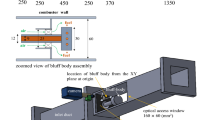As a non-invasive tool, ultrasound waves can be applied to probe gaseous content of the drilling fluid in offshore oil-drilling operations. The approach is believed to improve sensitivity and accuracy of a gas-kick detection system. In this research, four types of bubble flow are designed to simulate undeveloped gas kicks, and their effects on changes of ultrasound waves are investigated. The bubbles are found to have changed power distribution of the sound waves that have been reflected by the bubbles and received by side sensors. The pattern of power spectrum changes around the master frequency is found to be closely related to the type of bubble flow. Such changes are grouped on the basis of cluster analysis, and it is found that bubble strings and bubble groups would produce substantially different effects and that bubble mergences would largely alter spectral property of the sound waves. By establishing relationship between power-change pattern of sound waves and the behavior of a bubble flow, the research is intended to seek a more predictive way of recognizing early-stage gas kicks for offshore oil-drilling practices.









Similar content being viewed by others
Reference
Chen P. and Ma T.S. “Research status of early monitoring technology for deepwater drilling overflow”, J. Acta Petrolei Sinica, 35, 3: 602-612(2014).
Geng Y. N., Li Y. M., Zhu L., et al. “Study on real-time ultra-sonic kick detection technique along riser during deep water drilling operation”, J. China Offshore Oil and Gas, 28, 1: 86-92(2016).
Xu Y. Q., Guan Z. C., Zhang H. Z., et al. “A calculation method of the maximum allowable gas invasion overflow in deepwater drilling”. J. Natur. Gas Ind, 36, 7: 74-80(2016).
Li Y. M., Zhang W. G., Zhou Y. J., et al. “Design and offshore tests of monitoring system on gas cut of riser based on ultrasonic Doppler”. J. Journal of Safety Science and Technology, 13, 12: 20-26(2017).
Xu L.J. and Xu L.A. “Gas/liquid two-phase flow regime identification by ultrasonic tomography”. J. Flow Meas. Instrum, 8, 3: 145-155(1997).
Muhammad D.S., Yoshifumi M, Akinori M, et al. “The investigation of gas holdup distribution in a two-phase bubble column using ultrasonic computed tomography”. J. Chemical Engineering Journal, 130, 2-3: 125-133(2007).
Rahim R.A., Rahiman M.H.F., Chan K.S., et al. “Non-invasive imaging of liquid/gas flow using ultrasonic transmission-mode tomography”. J. Sensors and Actuators A: Physical, 135, 2: 337-345(2007).
Sascga L., Michael V., Helmut E., et al. “A real-time ultrasound process tomography system using a reflection-mode reconstruction technique”. J. Flow Measurement and Instrumentation, 53: 107-115(2017).
Tan C., Li X., Liu H., et al. “An Ultrasonic Transmission/Reflection Tomography System for Industrial Multiphase Flow Imaging”. J. Ieee Transactions on Industrial Electronics, 66, 12: 9539-9548(2019).
Yang W.Q. and Peng L.H. “Image reconstruction algorithms for electrical capacitance tomography”. J. Meas. Sci. Technol., 14.1: R1-R13(2003).
Nor M.N.A, Mohd H.F.R, Zulkarnay Z., et al. “Detection of small gas bubble using ultrasonic transmission-mode tomography system”. In: 2010 IEEE Symposium on Industrial Electronics and Applications (ISIEA 2010), Penang, Malaysia, 3-5 October, pp.165-170.
Joseph L.G., Fred K.F. and Jens E.J. “Measurement of fluid turbulence based on pulsed ultrasound techniques. Part 1. Analysis”. J . Fluid Mech, 118: 445-470(1982).
Acknowledgements
This work was financially supported by The National Key Research and Development Program in China (2023YFC3009201). The authors greatly acknowledge the comments and suggestions provided by reviewers and editors.
Author information
Authors and Affiliations
Corresponding author
Additional information
Translated from Khimiya i Tekhnologiya Topliv i Masel, No. 2, pp. 89–95, March– April, 2024.
Rights and permissions
Springer Nature or its licensor (e.g. a society or other partner) holds exclusive rights to this article under a publishing agreement with the author(s) or other rightsholder(s); author self-archiving of the accepted manuscript version of this article is solely governed by the terms of such publishing agreement and applicable law.
About this article
Cite this article
Li, Y., Wang, P., Liu, Y. et al. Detection of Bubble Flow by Cluster Analysis of Ultrasound Waves’ Spectral Properties. Chem Technol Fuels Oils 60, 324–333 (2024). https://doi.org/10.1007/s10553-024-01687-w
Published:
Issue Date:
DOI: https://doi.org/10.1007/s10553-024-01687-w




